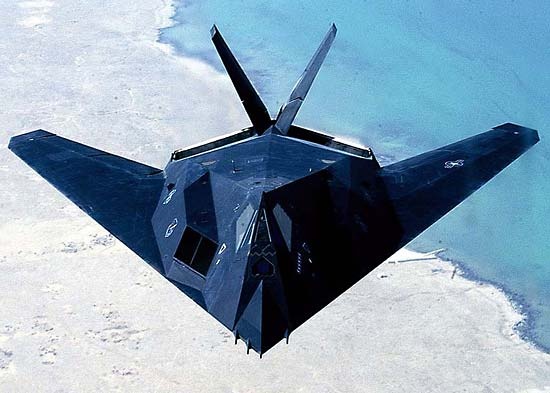F-117
aircraft
also called Nighthawk,
 single-seat, twin-engine jet fighter-bomber built by the Lockheed Corporation (now part of the Lockheed Martin Corporation) for the U.S. Air Force. It was the first stealth aircraft—i.e., an aircraft designed entirely around the concept of evading detection by radar and other sensors. After a difficult development period, during which several prototypes crashed during testing, the first operational craft was secretly delivered to the Air Force in 1982. The existence of the aircraft was officially acknowledged in 1988, and production ended in 1990.
single-seat, twin-engine jet fighter-bomber built by the Lockheed Corporation (now part of the Lockheed Martin Corporation) for the U.S. Air Force. It was the first stealth aircraft—i.e., an aircraft designed entirely around the concept of evading detection by radar and other sensors. After a difficult development period, during which several prototypes crashed during testing, the first operational craft was secretly delivered to the Air Force in 1982. The existence of the aircraft was officially acknowledged in 1988, and production ended in 1990.The F-117 has its origins in a request made in 1974 by the Advanced Research Projects Agency (ARPA) of the U.S. Department of Defense for a military aircraft that would emit or reflect so little radio, infrared, or light energy that it could slip undetected through an enemy's electronic warning system. As developed by Lockheed's Advanced Development Projects division (known as the “Skunk Works” for its top-secret work on such aircraft as the U-2 and SR-71 spy planes), the F-117 has a triangular outline, with wings swept sharply back from the nose at a 67° angle, and a surface composed of many flat planes oriented in such a manner as to reflect radar waves away from their transmitter. Radar reflection is further reduced by surface coatings of radar-absorbing material. Power is supplied by two General Electric turbofan engines, which, having no afterburners, limit the aircraft to subsonic speeds but reduce its infrared emissions. Weaponry, consisting of laser-guided bombs or radar-seeking or infrared-seeking missiles, is carried internally. By using inertial guidance, infrared sensors, digital maps, and radio commands from satellites or other aircraft, the F-117 can navigate without emitting its own telltale radar signals. F-117s flew hundreds of missions in the precision bombing of Iraqi installations during the Persian Gulf War of 1990–91.
- allosteric control
- allotropy
- Allouez, Claude-Jean
- Alloway
- alloy
- Allport, Gordon W.
- All Saints' Day
- All Souls' Day
- allspice
- All-Star Game
- Allston, Robert
- Allston, Washington
- All's Well That Ends Well
- allusion
- alluvial fan
- alluvium
- Al- Luḥayyah
- Allvar Gullstrand
- allée
- Allégret, Marc
- Allégret, Yves
- Allāh
- Al- Lāhūn
- al- Lāt
- Alma